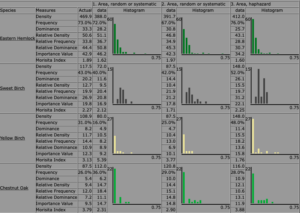In the virtual forest tutorial, a systematic sampling method, a simple randomized sampling method, and a haphazard sampling method were used to determine the frequency of seven tree species. The systematic sampling method involved randomly selecting a point along the southern margin of the study area and running a transect, straight north, through the five topographical regions (Southern Ridge Top, North Facing Slope, Bottomland, South-Facing Slope, and Northern Ridge Top). Samples were then taken from 24 quadrats (alternating between the eastern side and western side of the transect) until the northern margin was reached. The simple randomized sampling method involved generating 24 random locations to collect data. Finally, my haphazard method of sample collection involved attempting to space the quadrats in such a way that they maximized the distance between each other and the edge of the study area.
Based on the estimated sampling times, the haphazard method proved to be the fastest method (12:17 hrs) of sampling, and the simple random sampling method ended up being the slowest (12:45 hrs). However, I think it is worth noting that the systematic sampling method was, anecdotally, the fastest to conduct in the simulation and it seems logical that it should be considerably faster that either of the other two methods. This is because it covered much less walking distance than the random and haphazard method.
The two most common species in the study area were eastern hemlock and red maple. For eastern hemlock, the haphazard sampling method yielded a 6.9% error, the systematic sampling method yielded a 13.2% error, and the random sampling method yielded a 26.4% error. For red maple, the haphazard sampling method yielded a 17.0% error, the systematic sampling method yielded a 5.1% error, and the random sampling method yielded a 5.9% error. In both cases, the systematic method was more accurate than the random method, and the haphazard varied from being the best and the worst method.
The two most rare species in the study area were striped maple and white pine. For striped maple, the haphazard sampling method yielded a 100% error, the systematic sampling method yielded a 31.4% error, and the random sampling method yielded a 42% error. For white pine, the haphazard sampling method yielded a 98% error, the systematic sampling method yielded a 185% error, and the random sampling method yielded a 49% error. The systematic sampling method was most accurate for the striped maple; however, the random method wasn’t far off. In the case of the white pine, the systematic sampling method was extremely inaccurate and the random method was the most accurate. The haphazard method was extremely inaccurate in both cases.
Overall, the haphazard method out-performed the other methods for four out of the seven species. However, it was extremely inaccurate with determining the frequency of rare species and red maple. The inconsistent percent error values of the haphazard method lead me to believe that this method has value; however, it is a risky sampling strategy. I believe that the success from my haphazard approach is likely derived from traits that it took from a stratified method. By choosing points that were relatively far away from each other, I, incidentally, chose a similar amount of points in each region (Southern Ridge Top, North Facing Slope, Bottomland, South-Facing Slope, and Northern Ridge Top). Similarly, the systematic method performed well in most cases but had a lot of challenge with the rare species. Therefore, even though the random sampling method only outperformed both other methods in one case, it was the most consistent for determining the frequency of common and rare species.




